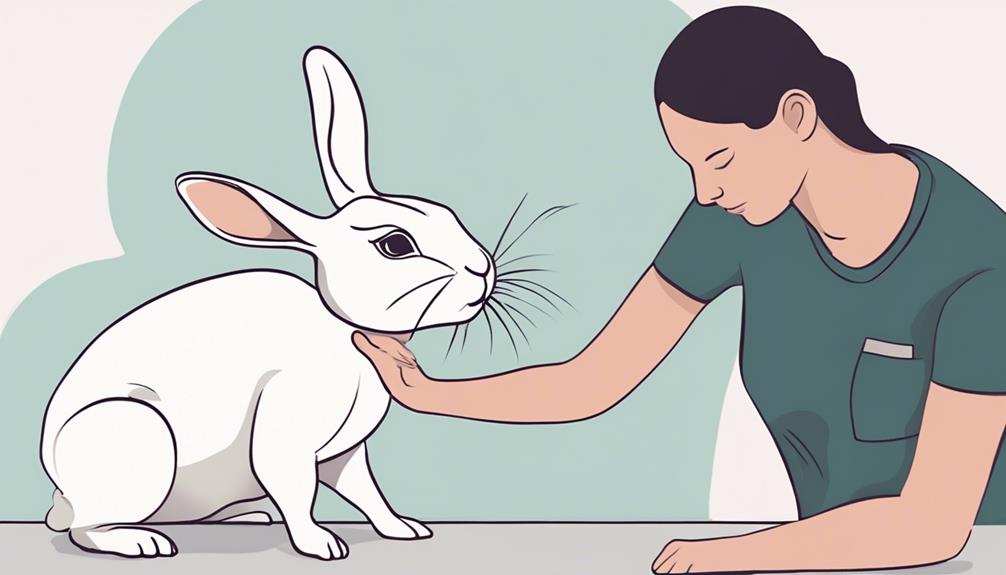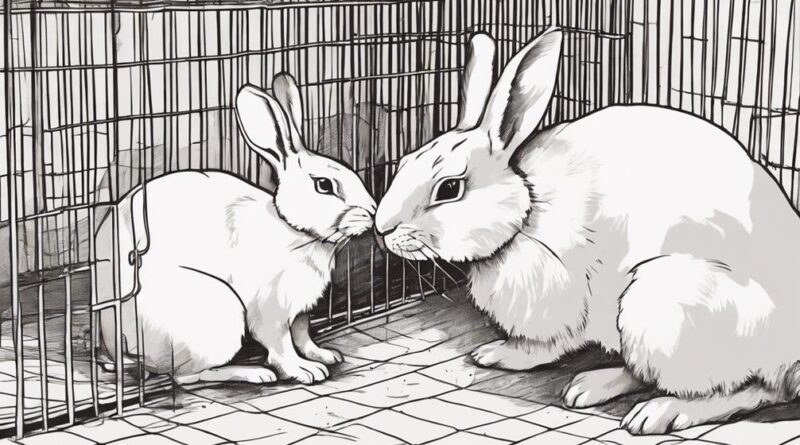Why Does My Rabbit Act Aggressively: Solutions?
Ever wondered why your once docile bunny now displays aggressive behavior? It's time to address this issue head-on.
By exploring the underlying causes and implementing effective solutions, you can foster a harmonious relationship with your furry companion. From understanding the triggers to seeking professional guidance when necessary, unraveling the mystery behind your rabbit's aggression is the first step towards a happier and healthier bond.
So, let's dive into the realm of rabbit behavior and discover the transformative power of positive reinforcement techniques and a conducive environment for your beloved pet.
Understanding Rabbit Aggression
Understanding rabbit aggression is crucial for effectively managing and addressing behavioral issues in your pet rabbit. Communication cues play a vital role in deciphering your rabbit's emotions. Behavioral changes, such as increased aggressiveness or fearfulness, can indicate underlying issues that need attention. By understanding your rabbit's body language and stress signs, you can better interpret their feelings and respond appropriately.
Rabbits communicate through various cues, such as thumping their hind legs when scared or agitated. These behaviors can serve as warning signs that your rabbit is feeling stressed or threatened. Paying attention to these communication cues can help you identify potential triggers for aggressive behavior.
Moreover, observing your rabbit's body language is key to understanding their emotions. For instance, flattened ears or a tense body posture may indicate that your rabbit is feeling anxious or defensive. By recognizing these subtle signals, you can intervene before a situation escalates into aggression.
Stress signs in rabbits can manifest in different ways, including excessive grooming, loss of appetite, or becoming more withdrawn. It's essential to address these stressors promptly to prevent aggressive behavior from developing. By being attuned to your rabbit's communication cues, behavioral changes, body language, and stress signs, you can effectively manage and mitigate aggression in your pet rabbit.
Identifying Triggers and Patterns
To effectively address aggression in your pet rabbit, start by identifying triggers and patterns that may be contributing to their behavior. Recognizing signs of aggression in rabbits is crucial in understanding what might be causing their behavior. Common triggers include fear, territoriality, pain, or feeling threatened. Pay attention to your rabbit's body language, such as thumping feet, growling, or charging, as these can indicate their emotional state. By identifying these triggers, you can work towards behavior modification to help your rabbit overcome their aggression.
Behavior modification techniques can help address aggressive behaviors in rabbits once triggers and patterns have been identified. Positive reinforcement through treats or toys can be used to reward calm and non-aggressive behavior. Redirecting their attention to more appropriate activities when they show signs of aggression can also be effective. Consistency is key in behavior modification, so make sure to respond to aggression promptly and consistently to reinforce positive behavior.
Creating a Safe Environment
Ensure your rabbit's environment is safe and conducive to their well-being by implementing appropriate measures to prevent potential hazards. Start by creating a designated area for your rabbit that's free from dangerous objects or substances. Remove any wires, small items that could be ingested, toxic plants, or sharp objects that may harm your rabbit. Provide a secure enclosure that allows your rabbit to move freely while ensuring they can't escape or encounter other household pets that may cause stress.
When handling your rabbit, practice safe techniques to avoid triggering any aggressive behavior. Approach them calmly and gently, avoiding sudden movements or loud noises. Support their body securely to prevent any feelings of insecurity or fear that may lead to aggression. Additionally, ensure that your rabbit has a safe space to retreat to when they feel overwhelmed or stressed. This could be a hiding spot within their enclosure or a cozy area in your home where they can relax undisturbed.
Managing stress is crucial in creating a safe environment for your rabbit. Establish a routine that includes regular feeding times, play sessions, and quiet periods for rest. Introduce new experiences gradually to prevent overwhelming your rabbit. By promoting a calm and predictable environment, you can help your rabbit feel secure and reduce the likelihood of aggressive behavior.
Implementing Positive Reinforcement
To foster positive behaviors in your rabbit, rewarding desired actions with treats or praise can be an effective method. Behavior modification through reward-based training is a powerful tool to encourage good behavior in your rabbit. When your rabbit displays the desired behavior, such as using the litter box or not biting, immediately reward them with a treat they enjoy or offer verbal praise. This positive reinforcement helps your rabbit associate their actions with pleasant outcomes, increasing the likelihood of them repeating the behavior.
Consistency is key when implementing positive reinforcement. Make sure to reward your rabbit every time they exhibit the desired behavior to reinforce the connection between the action and the reward. Over time, your rabbit will learn that engaging in these behaviors results in positive consequences, leading to behavior modification.
It's essential to choose rewards that your rabbit finds highly motivating. Experiment with different treats to see what they respond to best. Some rabbits may prefer small pieces of fruits or vegetables, while others may be more motivated by special rabbit treats from the pet store. By understanding what rewards work best for your rabbit, you can effectively utilize positive reinforcement to encourage good behavior.
Socializing and Bonding Techniques
When socializing and bonding with your rabbit, spend time in their environment to build trust and familiarity. This is crucial for establishing a strong connection with your pet. Here are some tips to help you socialize and bond effectively:
- Playtime activities:
Engage in interactive play sessions with your rabbit using toys like tunnels, balls, or cardboard boxes. This not only provides mental stimulation but also strengthens the bond between you and your rabbit.
- Handling techniques:
Practice gentle handling techniques to make your rabbit feel secure and comfortable in your presence. Approach them calmly and avoid sudden movements. Gradually introduce petting and grooming to build a positive association with physical contact.
- Create a safe environment:
Ensure the space where you interact with your rabbit is safe and free from potential dangers. Rabbits are sensitive prey animals, so a secure environment will help them feel more at ease during bonding sessions.
- Establish a routine:
Rabbits thrive on routine, so try to create a consistent schedule for feeding, playtime, and social interactions. Predictability can help reduce stress and build trust with your rabbit over time.
Seeking Professional Help When Needed
If you encounter challenges in managing your rabbit's aggressive behavior, consider consulting a professional for expert guidance and support. Behavior therapy can be incredibly beneficial in addressing underlying issues that may be causing your rabbit's aggression. A qualified animal behaviorist or veterinarian with experience in rabbit behavior can provide valuable insights into why your rabbit is acting aggressively and develop a customized behavior modification plan to address these issues.
Additionally, anxiety management is crucial in helping your rabbit overcome aggressive tendencies. A professional can help you identify sources of stress or anxiety in your rabbit's environment and work with you to create a calm and secure space for your pet. Techniques such as environmental enrichment, establishing routines, and using positive reinforcement can all play a role in reducing your rabbit's anxiety levels and promoting more peaceful behavior.
Consistency in Training Approaches

Consider maintaining consistency in your training approaches to effectively address your rabbit's aggressive behavior. Consistent reinforcement and behavior modification techniques play a crucial role in helping your rabbit overcome aggression.
Here are some key points to keep in mind:
- Consistent Reinforcement: Ensure that you consistently reward desirable behaviors and discourage negative ones. Use treats, toys, or positive verbal cues to reinforce good behavior immediately.
- Clear Communication: Be consistent in your verbal and non-verbal cues. Your rabbit will respond better if they receive clear and consistent signals from you. For example, use the same command or gesture every time you want to correct a behavior.
- Routine Training Sessions: Establish a regular training schedule to work on behavior modification techniques. Consistency in the timing and duration of these sessions can help your rabbit understand expectations better.
- Unified Approach: If multiple people are involved in training your rabbit, ensure everyone follows the same training methods and rules. Inconsistencies in training approaches can confuse your rabbit and hinder progress in addressing aggressive behavior.
Monitoring Progress and Adjusting Strategies
To effectively address your rabbit's aggressive behavior, monitor progress regularly and adjust strategies as needed. Tracking behavior is crucial in understanding how your rabbit is responding to the techniques you're implementing. Keep a journal or use a behavior tracking app to note any changes in your rabbit's aggression levels. By documenting these behaviors, you can identify patterns and determine which strategies are effective and which need modification.
When tracking behavior, pay attention to specific triggers that lead to aggression. Note the time of day, activities, or interactions that precede any aggressive episodes. This information can help you pinpoint potential sources of stress for your rabbit and adjust their environment or routines accordingly.
In addition to tracking behavior, be prepared to modify techniques if you're not seeing improvements in your rabbit's aggression. It's essential to be flexible and open to trying different approaches to find what works best for your rabbit. If a particular method isn't yielding the desired results, don't hesitate to switch it up and explore new training techniques.
Frequently Asked Questions
Can Rabbits Be Trained to Be Less Aggressive Towards Other Animals in the Household?
When dealing with aggressive behavior in rabbits towards other animals, behavioral training is key.
You can train your rabbit to be less aggressive by using positive reinforcement and rewards.
Through desensitization techniques, gradually expose your rabbit to other animals in a controlled and positive environment.
How Can I Tell if My Rabbit's Aggression Is Due to Fear or Territorial Behavior?
To determine if your rabbit's aggression stems from fear or territorial behavior, observe their body language. Fear-based aggression may involve thumping, crouching, or avoiding eye contact.
Territorial aggression could include lunging, nipping, or marking with urine. When handling your rabbit, be gentle and calm to ease any fear they may have.
Understanding the root cause of their aggression can help you address it effectively.
Are There Specific Breeds of Rabbits That Are More Prone to Aggression?
Some rabbit breeds exhibit natural tendencies towards aggression. These inclinations can be triggered by various factors. Understanding breed-specific behaviors can help you anticipate and manage potential aggression.
Additionally, temperament differences among rabbit breeds may influence their propensity for aggression. Proper handling techniques tailored to your rabbit's breed can help mitigate aggressive behaviors and foster a harmonious relationship between you and your furry companion.
Can Diet and Exercise Play a Role in Reducing Rabbit Aggression?
To reduce rabbit aggression, consider adjusting your pet's diet and exercise routine. Dietary changes can impact behavior. Ensure they've a balanced diet.
Regular exercise can also help release excess energy. Behavior modification and socialization techniques can also be beneficial. Positive interactions can improve your rabbit's demeanor.
How Can I Prevent My Rabbit From Becoming Aggressive During Grooming or Nail Trimming Sessions?
When grooming or trimming your rabbit's nails, behavior modification is key in preventing aggression. Start by introducing positive reinforcement during non-grooming interactions to create a positive association with handling.
Slowly desensitize your rabbit to grooming tools by letting them sniff and explore them first. Reward calm behavior with treats during grooming sessions to reinforce positive behavior. Consistent training and patience will help your rabbit feel more comfortable during grooming.
Conclusion
In conclusion, understanding your rabbit's aggression, identifying triggers, creating a safe environment, and implementing positive reinforcement are key steps to address and prevent aggressive behavior.
Consistency in training, socializing, and seeking professional help when needed are also important aspects to consider.
By monitoring progress and adjusting strategies as needed, you can help your rabbit overcome aggression and build a stronger bond with them.
